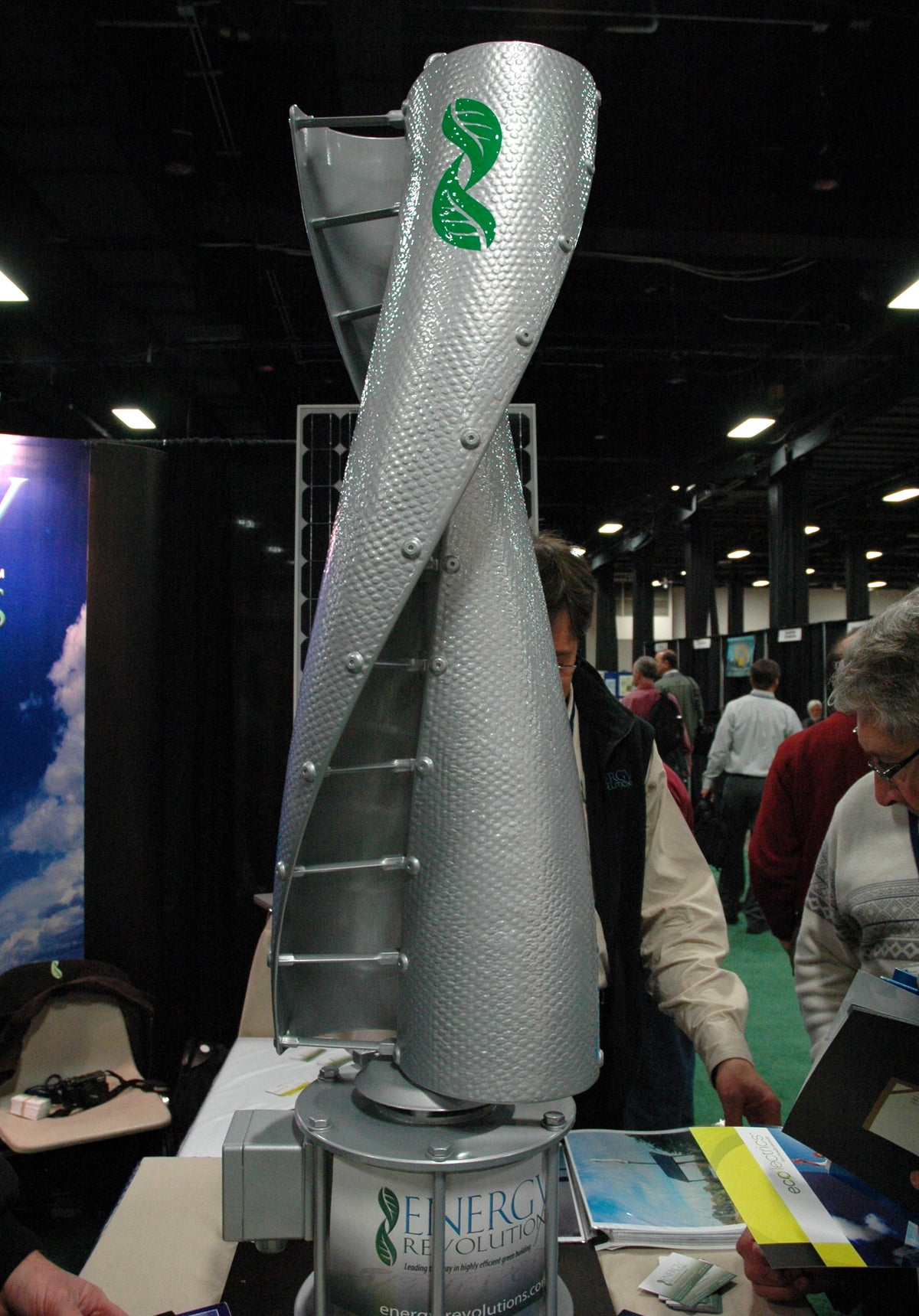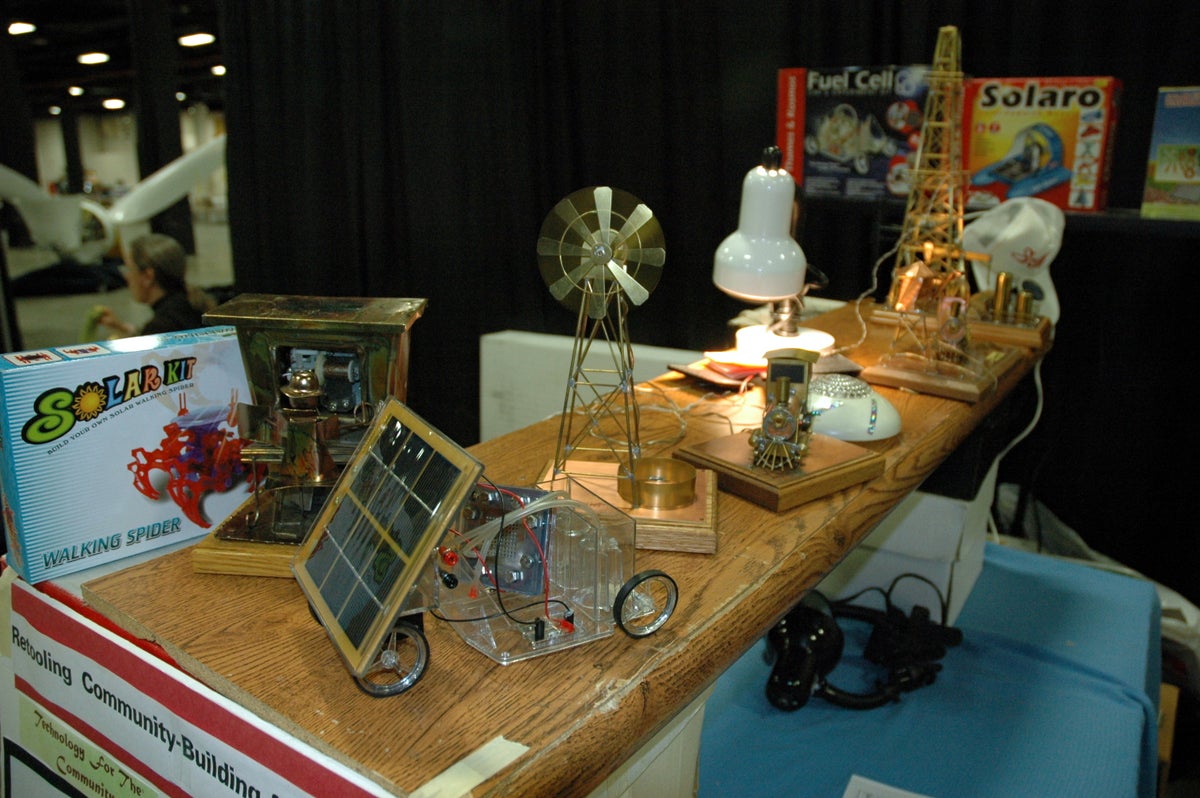Photo quiz: Gear for green buildings
Think you know your way around a green building? Look at each photo to test your knowledge of green-building gadgetry.

Energy Revolutions
There's lot of talk of making homes "greener" through energy efficiency or distributed renewable energy. But what's the equipment that you need to do this?
This photo gallery will give you a glimpse of what's involved and test your knowledge along the way. The slideshow is both a collection of nifty images from the North East Sustainable Energy Green Building Conference, which took place last week in Boston, and an interactive quiz.
Each photo will have a question. Click to the next photo to get the answer and another question. Keep track of how many you get right. At the end, there will be a highly subjective "energy geek" rating system.
First question: What is this device from Energy Revolutions?
A. An industrial corkscrew to clear water mains
B. A vertical-axis wind turbine
Answer next page. (Don't worry, the questions get harder.)
Practical Solar heliostat
The answer to the previous question is B, a vertical-axis wind turbine capable of generating 1 kilowatt of electricity. A larger version of the same design is installed on Esther's Island near Nantucket.
Next question: This heliostat from Practical Solar is used to:
A. bring sunlight into buildings to cut lighting costs.
B. convert sunlight into electricity.
Answer and new question on next page.
Red door
The answer to the previous question is A. A heliostat is any device that tracks the movement of the sun to reflect light. Heliostats can be used for daylighting (bringing natural light indoors) or to concentrate the sun's light to make heat to turn a steam turbine.
Next question: These blower doors are used for:
A. testing a home's air leaks during an energy audit.
B. airing out a home after a cigar-heavy poker game.
Answer and new question on next page.
Tubes
The answer to the previous question is A. A blower door attaches to a home's outside door. The fan blows air outside, exaggerating the air leaks in a home, which is one way to find places to plug when trying to make a building more air-tight.
Next question: These evacuated tubes are used for:
A. solar hot water systems.
B. ground-source heat pumps.
Answer and new question on next page.
Model home
The answer to the previous question is A. Those tubes are cutting-edge solar hot water technology. The tubes circulate a combination of water and alcohol, which turns to steam in the sun. The heat generated by the tubes is eventually transferred to a hot water tank to preheat a traditional hot water heater.
Next question: This building has two types of solar energy technologies on it. Pick the correct combination:
A. Two solar hot water panels on left and three solar photovoltaic panels on right.
B. Five solar photovoltaic panels.
Answer and new question on next page.
Coils
The answer to the previous question is A. On the left are two flat-panel solar collectors for heating hot water. Tubes are another solar thermal technology. The three panels to the right are solar photovoltaic modules that convert sunlight to electricity.
Next question: What is this device?
A. A tank for a domestic solar hot water system.
B. A Tesla coil for generating high-voltage electricity.
Answer and new question on next page.
Inverter
The answer to the previous question is A, a hot water tank for use with a solar collector. The heated liquid from solar collectors passes through the coils to heat the water inside the tank.
Next question: An inverter like this one is used for:
A. converting direct current from a wind turbine or solar panels to alternating current.
B. converting alternating current from a wind turbine or solar panels to direct current.
Answer and new question on next page.
Camera
The answer to the previous question is A. Wind and solar power sources need to have an inverter device to convert the high-voltage signal they generate to household-compatible alternating current.
Next question: This camera is:
A. a thermal imaging camera for finding holes in a building's insulation and air sealing.
B. a prototype of secret Apple product for filming movies about green buildings.
Answer and new question on next page. (Next one's tougher.)
Thermal image
The answer to the previous question is A. Thermal imaging cameras give energy auditors a way to see if a home's "thermal envelope" is even and tight and there is minimal air leakage.
Next question: What is this thermal image a picture of and what does it tell you?
Answer and new question on next page.
Correction: This slide originally showed an incorrect thermal image. The proper image has been swapped in.
Castle
The answer to the previous question is that it's a picture of the bottom of a doorway. The blue and purple light along the middle of the image tell an energy auditor that there is a lot of air leakage going on there and that some weatherstripping is in order.
Next question: What is this?
A. The entrance to a Smurfs castle, or
B. A passageway built from insulating foam.
Answer and new question on next page. (Good luck on this next one.)
Machine
The answer to the previous question is B, insulating and air-sealing foam from a company called Iclyene. If you've done any serious work on retrofitting a home to be more energy efficient, you know that foam--which hardens in a few hours--can be used extensively to seal air holes to stop leaks or build funny-looking structures.
Next question: This machine is used to heat a home. It is :
A. ground-source heat pump.
B. micro-combined heat-and-power system.
Answer and new question on next page.
Geothermal
The answer to the previous question is B, a micro-combined heat-and-power system, which is considered a very efficient technology. This product is called the FreeWatt from ECR International. It's a machine that burns natural gas in a Honda internal combustion engine to make electricity. The heat given off from that power production is used to heat a home. First introduced in 2007 in Massachusetts, the company is now expanding nationally.
Next question: True or false: A ground-source heat pump--sometimes referred to as a geothermal system--heats and cools a home by tapping the earth's heat.
A. True
B. False
Answer and new question on next page.
Sensors
The answer to the previous question is B, false. There is such a thing as geothermal power where underground heat is indeed used to make electricity. But ground-source heat pumps--often confusingly called geothermal--don't actually use underground heat. Instead, they use the steady temperature of the earth to store energy. The inside of this unit shows the condenser on the bottom which extracts heat or cooling from a circulating fluid and the heat exchanger on top.
Next question: This renewable energy monitoring system from SolarWave Energy is for:
A. monitoring solar hot water installations via sensors and Web services.
B. monitoring solar electric systems via sensors and Web services.
Answer and new question on next page.
Wind turbine
The answer to the previous question is A, solar hot water. This monitoring equipment gathers data on weather conditions such as temperature and humidity, and the performance of solar hot-water collectors. The manufacturer, SolarWave Energy, has designed the product for installers to spot problems and for utility grid planners to measure the impact of solar hot water systems on natural gas use. This isn't really a fair question (you'd have to be a sensor expert to know the answer), but I had to introduce an element of luck into this!
Next question: What is the name of the wind turbine part pictured here?
A. The generator
B. The nacelle
Answer and new question on next page.

Green-tech toys
The answer to the previous question is B, a nacelle. A nacelle refers to the housing behind the blades that holds the generator, gear box, and other equipment that converts the kinetic energy of the wind into mechanical energy, which is then turned into electricity.
The quiz is over. How many did you get right? Use my handy rating system here:
12-14: You're a serious energy geek. Welcome to the tribe.
8-12: Not bad. You've probably gotten a home energy audit and know a bit about renewable energy.
0-8: You need some work. Read the CNET Green Tech blog and you'll get up to speed.

